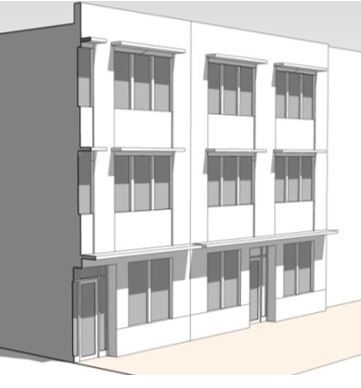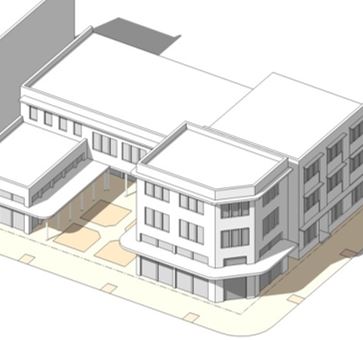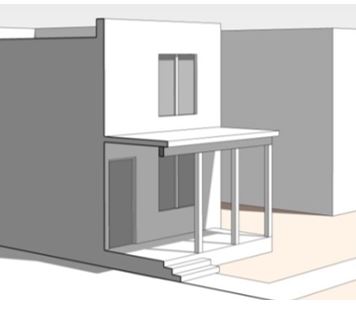Section 1205. Frontage Standards.
A. Intent. The frontage standards and types in this section regulate the area between the property line and the front facade of a building in order to support an urban, pedestrian and transit-oriented environment.
B. Building Facade General Standards.
1. The Design Review Committee (DRC) may approve a frontage design alternative when the design meets the intent of pedestrian and transit-oriented frontages and facades. Such requests may be filed by applicants for consideration by the Design Review Committee per Section 1224.
2. Building facades may include multiple frontage types along the length of the project.
3. Building entrances shall face toward the street in order to meet the intent of activating the public realm.
4. Building facades shall be designed to provide a sense of human scale at the ground level by providing a clear architectural distinction between the ground floor and all additional stories.
a. Side and rear building facades should have a level of trim and finish compatible with the front facade, particularly if they are visible from the street.
5. Fence standards for properties located within a Historic Preservation (HP) Overlay District. Fences or freestanding walls in the front setback may not exceed a maximum height of three feet, and are conditioned upon obtaining a certificate of appropriateness or no effect in accordance with Section 812. This height limitation extends to a point three feet beyond the front corner(s) of the primary structure.
C. Projections in the Right-of-Way.
1. Where public utility easements, water/sewer lines or irregular lot lines cause conflicts with specific frontage types and frontage setback types, Planning and Development staff may modify numeric setback and landscape requirements up to 20 percent and allow build-to dimensions to be taken from the back of the public utility easement.
2. Any projections into public right-of-way should be permitted only upon issuance of an encroachment permit as administered by the City of Phoenix, and if applicable, approval from affected public utility companies.
3. A minimum 16-foot height clearance should be provided from public water/sewer lines, unless shade is retractable or an encroachment permit is secured from the City of Phoenix.
D. Frontage Type: Active Front Yard.
1. Definition. An Active Front Yard is the area between the property line and main facade of the building with a permanent hardscaped or landscaped area that can accommodate seating.
2. A permanent hardscaped or landscaped area shall be provided in accordance with the following standards:
a. Minimum depth: Six feet.
b. Minimum width: 50 percent of the building facade.
d. Placement: Adjacent to the front facade of the building at the primary entry.
e. Materials: Hardscape shall consist of concrete slab, pavers, open grid pavers, wood decking (if elevated) or equivalent alternative.
3. Fences. Maximum height 40 inches.
4. A minimum of one primary entrance shall be provided along each frontage that directly connects to the street, unless a corner entrance is provided.
5. The area between the property line and main facade of the building which is not improved with permanent hardscape shall be landscaped in accordance with Section 1207.F, Landscape Standards.
E. Frontage Type: Dooryard.
1. Definition. A Dooryard incorporates a courtyard or patio at street level for each unit that is surrounded by a fence to provide privacy and to differentiate from the adjacent public sidewalk.
2. A permanent hardscape area shall be provided in accordance with the following standards:
a. Minimum depth: 8 feet.
b. Minimum area: 64 square feet.
c. Placement: adjacent to the front facade of the building at the building/unit entry.
d. Materials: hardscape shall consist of concrete slab, pavers, open grid pavers or equivalent alternative.
e. Spatial definition: Either a solid masonry wall a minimum of 30-inches and a maximum of 36-inches in height, or elevation of the hardscaped area a minimum of 30-inches and a maximum of 36-inches from adjacent grade. Open view fencing may be provided in addition to the wall or elevated area up to a maximum height of 72-inches from adjacent grade.
f. Pedestrian access: An opening in the masonry wall or stairs to the elevated area of a minimum 36-inches and maximum 48-inches in width.
3. Fences. Maximum height six feet.
a. This shall be measured from the ground and not the elevated door yard.
b. Fences placed at grade shall be a minimum 50 percent view fencing above 40 inches in height measured from finished grade.
4. The area between the property line and main facade of the building which is not improved with permanent hardscape shall be landscaped in accordance with Section 1207.F, Landscape Standards.
5. A minimum of one primary entrance shall be provided along each frontage that directly connects to the street, unless a corner entrance is provided.
6. Primary entrances must lead into an occupiable space.
F. Frontage Type: Stoop/Door Well.
1. Definition. A Stoop/Door Well is a type of facade that provides an entryway that is elevated (Stoop) or depressed (Door Well) to provide differentiation from the adjacent public sidewalk.
2. A landing area shall be provided in accordance with the following standards:
a. Minimum dimension: 6 feet.
b. Minimum area: 36 square feet.
c. Placement: adjacent to the front facade of the building at the building/unit entry.
d. Materials: concrete, stone, metal or equivalent alternative.
e. Spatial definition: Elevated a minimum of 24-inches and a maximum of 60-inches, or depressed a minimum of 24-inches and a maximum of 60-inches from adjacent grade.
f. Pedestrian access: Stairs a minimum 36-inches and maximum 48-inches in width.
3. Fences. Maximum height 40 inches.
4. The area between the property line and main facade of the building which is not improved with permanent hardscape shall be landscaped in accordance with Section 1207.F, Landscape Standards.
5. A minimum of one primary building entry shall be provided per street frontage.
6. Each ground floor residential unit adjacent to a street shall provide a primary entrance on the street side that directly connects to the street, unless a corner entrance is provided.
7. Primary entrances must lead into an occupiable space.
G. Frontage Type: Storefront Standards.
1. Definition. A Storefront means the area between the property line and main facade of the building when the building is located within ten feet of the property line and which includes a ground floor elevation with a high percentage of transparent windows to create visual interest from the adjacent public sidewalk. This frontage is traditionally used for retail, live/work, and other nonresidential active uses and may include a cantilevered canopy or awning.
2. The ground floor building elevation shall be designed in accordance with the following standards:
a. Minimum glazing: 75% of the area measured between 3 and 8 feet above grade for the entire width of the front facade.
b. Materials: Glazing shall allow a minimum of 75% of the visible light (as specified by the manufacturer) to be visible on either side of the window.
c. Spatial definition: Up to 50% of the front facade may be recessed up to 12 feet from the property line to enhance building entries or allow for outdoor dining.
3. Fences: maximum 40 inches.
a. Fences shall be a minimum 50% view fencing.
4. A cantilevered canopy, fixed awning or retractable awning shall be provided in accordance with the following standards:
a. Placement: Minimum 8 feet from curb. No projection or encroachment into public right-of-way is permitted unless a revocable permit is obtained from the Street Transportation Department.
b. Minimum depth: 5 feet.
c. Minimum length: 75% of front facade.
d. Minimum clear height: 10 feet.
5. A minimum of one primary building entry shall be provided per street frontage.
6. Each ground floor commercial suite adjacent to a street shall provide a primary entrance on the street side that directly connects to the street, unless a corner entrance is provided.
|
H. |
Frontage Type: Common Entry. This frontage type is appropriate when an entrance on the ground floor is required as the main access to upper floor residential and commercial units. This type should be used in conjunction with other frontage types to achieve the minimum requirement for active uses on the ground floor. |
||
|
Requirements: |

|
||
|
1. |
A collective entry to a multi-tenant lobby is required at the primary building entrance facing the street. |
||
|
a. |
Entry should be designed to provide a clear architectural distinction from the rest of the development. |
||
|
2. |
|||
|
3. |
If the frontage includes a stoop entrance: |
||
|
a. |
Stoop minimum dimension: six feet. |
||
|
b. |
Minimum area: 36 square feet. |
||
|
4. |
Stoops and related structures may project into frontage setbacks no more than ten feet. |
||
|
I. |
Frontage Type: Forecourt. The forecourt frontage type is appropriate for either residential or commercial development. The forecourt may be used as an entry court and shared garden space for residential uses, or as additional shopping or restaurant seating areas facing the street. |
||
|
Requirements: +2 |

|
||
|
1. |
Forecourts are allowed to set back from maximum setback standards in all Character Areas. |
||
|
2. |
Forecourt areas should be a minimum of 500 square feet with a minimum dimension of 20 feet parallel to the street. |
||
|
3. |
A maximum height of 40-inch open view fence permitted at outdoor seating areas and at building setback lines. |
||
|
4. |
Vehicular parking, loading and maneuvering within the forecourt are not permitted. |
||
|
5. |
A minimum of 50 percent of forecourt area shall be shaded, of which 50 percent of the shade should be provided by trees or trellised vines. |
||
|
6. |
Right-of-way shade requirements as per Section 1207.E. |
||
|
Activation and Glazing |
|||
|---|---|---|---|
|
7. |
Nonresidential forecourts: forecourt ground floor should be lined with active uses. Seventy-five percent minimum glazing requirement for frontages within the forecourt. |
||
|
8. |
Glazing at street frontage: minimum of 75 percent of the storefront area along a primary street ground floor frontage and 50 percent on secondary street ground floor frontage. |
||
|
J. |
Frontage Type: Porch. This frontage type includes a covered structure enclosing an outdoor area deep enough to ensure usability. The porch provides a transition between public and private space, and creates opportunity for interaction between neighbors. |
|
|
Requirements: |

|
|
|
1. |
||
|
2. |
A porch is required at the primary building entry. |
|
|
3. |
A primary building entrance per unit is required when fronting a street. |
|
|
4. |
Minimum depth: six feet. |
|
|
5. |
Minimum width: 50 percent of the facade. |
|
|
6. |
Porches and related structures may project into frontage setback no more than ten feet. |
|
K. Gallery/Arcade Standards.
1. Definition. A Gallery/Arcade means the area between the property line and main facade of the building that includes a ground floor elevation with a high percentage of transparent glazing to create visual interest from the adjacent public sidewalk and permanent structural shading which either projects from the front facade (Gallery) or is recessed under the front facade (Arcade).
2. The ground floor building elevation shall be designed in accordance with the following standards:
a. Minimum glazing: 75% of the area measured between 3 and 8 feet above grade for the entire width of the front facade.
b. Materials: glazing shall allow a minimum of 75% of the visible light (as specified by the manufacturer) to be visible on either side of the window.
3. Fences: Maximum 40 inches.
a. Fences shall be a minimum 50% view fencing.
4. A permanent shade structure shall be provided in accordance with the following standards:
a. Placement. The gallery/arcade shall extend to the edge of the Streetscape Zone and cover the entire sidewalk. No projection or encroachment into the public right-of-way is permitted unless a revocable permit is obtained from the Street Transportation Department.
b. Minimum depth: 10 feet.
c. Minimum length: 100% of front facade.
d. Minimum spacing between supports: 10 feet.
e. Minimum clear height at exterior opening: 10 feet. No maximum limit on interior clear height.
5. A minimum of one primary building entry shall be provided per street frontage.
6. Each ground floor commercial suite adjacent to a street shall provide a primary entrance on the street side that directly connects to the street, unless a corner entrance is provided.
L. Side Street Standards.
1. Definition. A Side Street Frontage is only for use along streets identified as Side Streets (Map 1202.E). This frontage type is used typically where alleys, driveways, loading and other vehicular activities occur along the street. Walkability, connectivity and safety are still critical functions along this frontage to enhance the Pedestrian Streets. These standards are a minimum and can be enhanced to promote greater walkability and access.
2. The ground floor building elevation shall be designed in accordance with the following standards:
a. A minimum 50 percent of the ground floor building facade shall include two or more of the following treatments:
(1) Green screen.
(2) Artwork (mural, mosaic, custom masonry, sculpture, relief, etc.).
(3) Small active use space (50-square-foot minimum newspaper stand, coffee cart, kiosk, etc., not vending machines or outdoor merchandise display).
(4) Outdoor dining patio, physically delineated by a low wall, fence or planters.
(5) Distinctive architectural lighting design.
(6) Shade structure.
(7) Changes to building plane, indentations, textures, or accent materials.
(8) Permanent seating (benches, perches, ledges, etc.)
(9) Windows that provide a minimum 75% of the visible light (as specified by the manufacturer) to be visible on either side of the window.
b. Up to 50% of the building facade may be recessed up to 12 feet from the property line to apply or utilize the ground floor building facade screening options.
3. Fences: Maximum height 8 feet.
a. Fences shall be a minimum 50% open view fencing.
4. A minimum of one building entry shall be provided per street frontage. This entry can be a service entry.
5. Downward pedestrian lighting shall be installed along or attached to the facade every 25 feet at a height no greater than 15 feet. (Ord. No. G-5480, 2010; Ord. No. G-5777, 2013; Ord. No. G-6409, 2018)